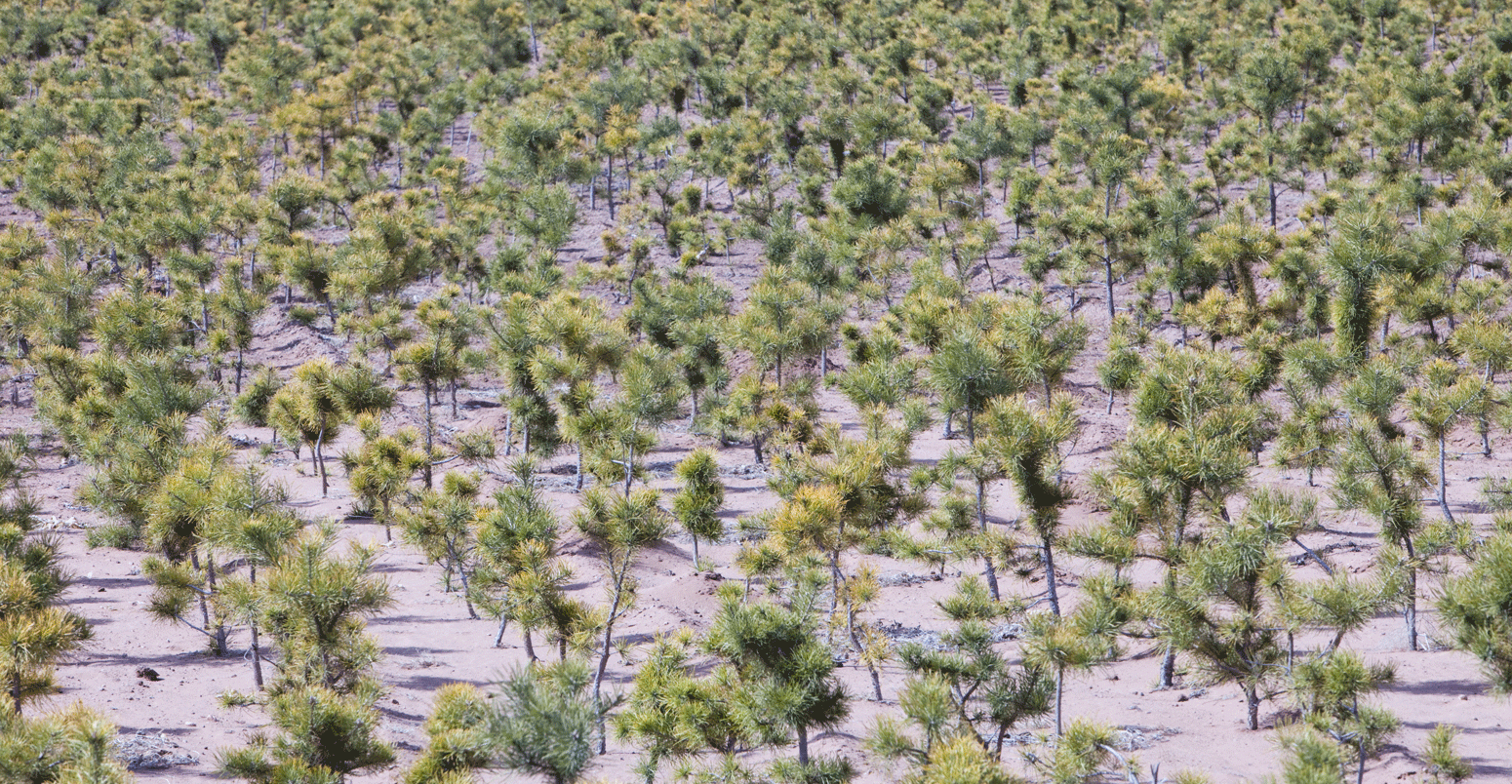
Analysis: Shell says new ‘Brazil-sized’ forest would be needed to meet 1.5C climate goal
Josh Gabbatiss
02.12.21Josh Gabbatiss
12.02.2021 | 8:00amFor the first time, Shell has released a “pathway” showing how the world could potentially meet the Paris Agreement’s ambitious goal of limiting global warming to 1.5C.
This marks a significant shift in attitude towards action on climate change, given that only six years ago executives at the oil-and-gas major were sceptical about warming not breaching 2C. It now says that the 1.5C goal could be achieved by 2100 with CO2 emissions reaching “net-zero” by 2058.
A pivotal moment came in 2018 when Shell outlined a ”plausible” route to meeting the Paris Agreement’s “well-below 2C” goal, including seeing “peak oil” in 2025 with “peak gas” following a decade later.
However, Carbon Brief analysis of Shell’s new “Sky 1.5” scenario shows that, despite its ”highly ambitious” framing, it is, in fact, nearly identical to its 2C predecessor. Shell’s vision of a continued role for oil, gas and coal until the end of the century remains essentially the same.
Aside from the temporary impact of Covid-19, the major difference between the two scenarios is the “extensive scale-up of nature-based solutions”, specifically planting trees over an “area approaching that of Brazil”.
Shell chief executive Ben van Beurden describes the 1.5C pathway as a “truly desirable destination”, but also one that is “highly challenging”. While he says Shell intends to “play its part”, the report also emphasises the role of “people” and “societies”.
‘Inevitable transition’
The new scenario was released this week in a package with two others, titled “Waves” and “Islands”. Like Sky 1.5, they map an energy future beyond the pandemic, but without meeting the world’s climate targets.
These scenarios are “not intended to be projections or forecasts of the future” and are “not Shell’s strategy or business plan”, a legal disclaimer states:
“Ultimately, whether society meets its goals to decarbonise is not within Shell’s control.”
Rather, the scenarios are described as “a useful tool for exploring future possibilities”.
Shell used to be resistant to the idea of publishing such ambitious visions. Jeremy Bentham, the firm’s head of scenarios, told Carbon Brief in 2015 that 2C targets had become politically and socially “less plausible”.
But a lot has changed since then. Later that year, nations signed the Paris Agreement, committing to hold global temperature rise to “well-below 2C” with a stretch goal of limiting warming to 1.5C.
Shell responded with its first public-facing vision for a 2C future shortly afterwards, albeit one that the company still viewed as unlikely. This plan was fleshed out two years later in its original “Sky” scenario.
In the following years, scientists hurried to fill the knowledge gaps on how the world could strive for the 1.5C scenario.
This culminated in the Intergovernmental Panel on Climate Change’s (IPCC) landmark special report on 1.5C, which Shell’s Sky scenario fed into. Stark warnings of coral die-offs and vanishing Arctic ice beyond 1.5C helped galvanise people and governments to act.
Shell cites climate activism and the wave of national net-zero pledges, along with technological innovations, evolving markets and the changing climate itself, as “growing pressures” that are driving an “inevitable transition”, although one that could still take many years.
The report emphasises that the “crisis” of Covid-19 could be “an opportunity” for the Sky 1.5 scenario, noting that “the required pace of change is extremely challenging, but technically and economically feasible if action accelerates decisively from now”.
As with the previous Sky scenario, Shell stops short of venturing whether it is socially or politically feasible. Bentham tells Carbon Brief:
“The main challenges are social and political, i.e. people making the necessary choices in a short timeframe. Time is running out for the world to start along it, but Shell is determined to help.”
Identical Skies?
In Sky 1.5, the planet’s temperature rises to 1.7C around the middle of the century, but eventually cools slightly to 1.5C by 2100 due to CO2 being removed from the atmosphere at an epic scale.
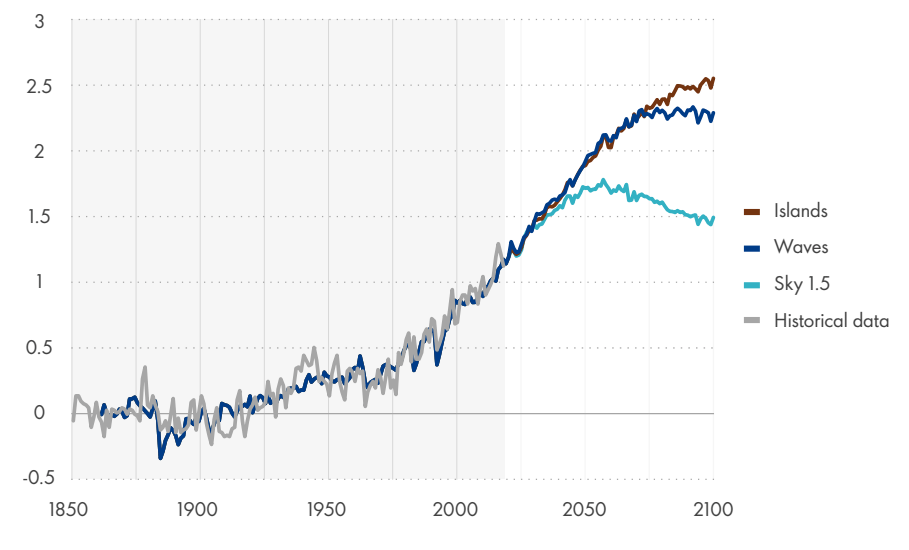
The report lays out a storyline for how the new scenario could play out over the coming decades, describing Sky 1.5 as a “health first” route – one in which, post pandemic, the health of both people and the environment are prioritised.
In a blog post accompanying the scenario’s release, Shell’s chief climate adviser David Hone says the path is “all about managing emissions, so coal drops out very early, CCS emerges rapidly and land is managed with conservation and carbon in mind”.
However, many of the key moments identified in the report – peak coal already passed, peak oil in 2025, peak fossil gas in the mid-2030s – are familiar, given they already appeared in Shell’s previous Sky scenario.
In fact, a comparison by Carbon Brief of the energy pathways identified in both scenarios shows that, apart from accounting for the Covid-related dip in the early 2020s, they are essentially the same.
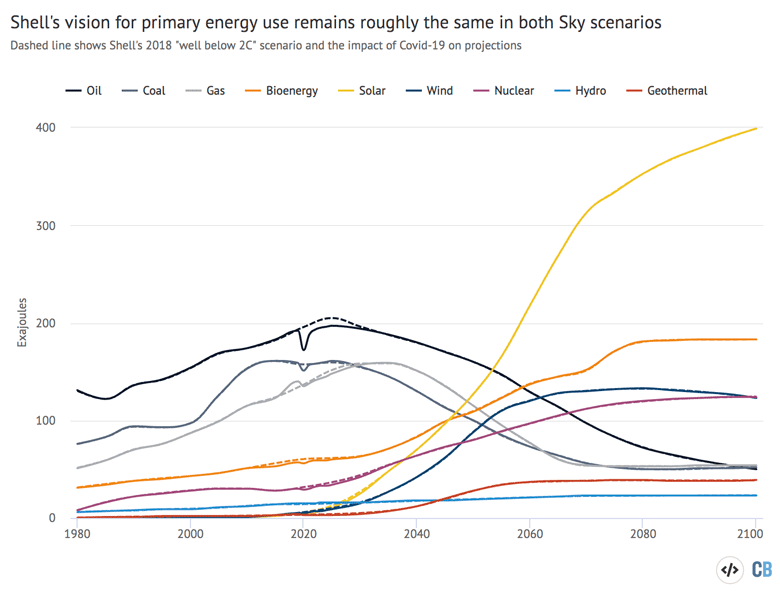
Oil-and-gas demand only drops decisively below pre-Covid levels around the middle of the century, with fossil fuels still widely used even in 2100. In its latest strategy update, Shell announced that its own CO2 emissions and oil production have peaked, but also said it would expand its gas operations in the coming years.
Other features of the new pathway, such as a massive scale up of solar power, electrification and largely unproven carbon capture and storage (CCS) technologies, also follow the same trajectory as the last Sky scenario.
All of this means that, when comparing energy-related CO2 emissions alone, the pathways for the 1.5C and “well-below 2C” are also similar, reaching net-zero around 2070.
The key difference, spelled out in an endnote at the bottom of the report, is that while the new pathway “starts with data” from the previous Sky pathway, it also includes the impact of CO2 removal using trees:
“The extensive scale-up of nature-based solutions is brought into the core scenario, which benefits from extensive new modelling of that scale-up.”
The report also describes exactly what such a scale-up would look like:
“Sky 1.5 requires major reforestation – some 700m hectares of land would be required over the century, an area approaching that of Brazil.”
Bentham tells Carbon Brief that as well as trees their models include “23 different types of nature-based solutions”, and says protecting existing forests will also be important.
The impact of incorporating these land-based emissions into the scenario is shown by the red line in the chart below, bringing the net-zero date to 2058.
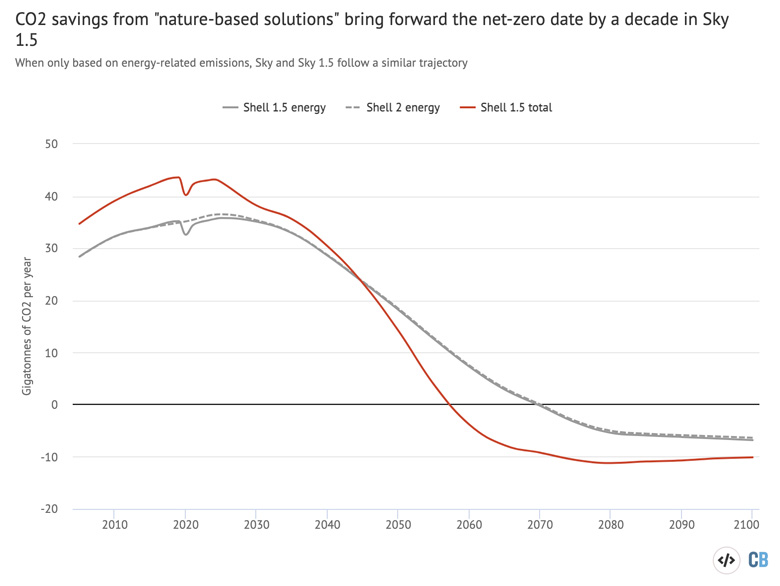
Although data on land-based emissions was not formally included in the previous Sky scenario, the idea is not actually new.
Work commissioned by Shell from the Massachusetts Institute of Technology (MIT) Joint Program on the Science and Policy of Global Change for the 2018 scenario found that “an area the size of Brazil being reforested offers the possibility of limiting warming to 1.5C”.
The Brazil comparison has also been used by Van Beurden, who told an industry conference in 2018: “It’s not what some people sometimes think: we’ll just do a little bit more solar, a bit more wind and we’ll get there.”
Other differences listed by Shell between the two Sky scenarios are “the latest historical data and estimates up to 2020” and “new oil and natural gas supply modelling, with an outlook consistent with the Sky 1.5 narrative and demand”.
‘Maximum potential’ for natural removals
In a summary of Sky 1.5, the report states the practical requirements are “mass deployment of cleaner technologies; changes in behavioural and investment choices; and removing emissions that would otherwise accumulate in the atmosphere”.
Meanwhile, Shell says that its main products, oil and gas, “will remain significant for decades” and “there needs to be continued investment in oil and gas supply”.
Prof Wim Carton, who studies the political ecology of carbon removal at Lund University, tells Carbon Brief he is concerned by this framing:
“If we start normalising the use of these planetary scale negative emissions it allows a company like Shell to basically claim they are in line with apparently whatever climate target you come up with, just by assuming large-scale negative emissions and at the same time saying we need to invest in oil and gas development.”
The scenario relies on around 12 gigatonnes of CO2 (GtCO2) being removed annually using reforestation by 2060.
Bentham says that “although the scale of the task is very large”, research from institutions such as MIT and The Nature Conservancy suggests the “CO2 drawdown in Sky 1.5 is feasible through reforestation and land carbon uptake”.
Dr Joeri Rogelj, a climate scientist at Imperial College London who is involved in modelling 1.5C pathways, tells Carbon Brief that the figures quoted amount to the “maximum potential” of all possible nature-based removals that have previously been modelled.
At the same time, the scenario requires the amount of bioenergy to more than double, which Rogelj says could be an issue:
“That really needs to be clarified – how those two go hand-in-hand – because afforestation needs land and if that land is used for bioenergy production that doesn’t really work.”
In the Sky 1.5 pathway, cumulative CO2 emissions after 2018 will peak at 1,149GtCO2 in 2057. Beyond this, they decline as CO2 is sucked from the atmosphere until cumulative emissions settle at 747GtCO2 in 2100.
This “carbon budget” is higher than the 580GtCO2 given by the IPCC for a 50% probability of limiting warming to 1.5C. Since the IPCC came up with its figure in 2018 the remaining budget has shrunk by a further 120GtCO2, according to the Shell report.
However, there are a variety of estimates for the remaining carbon budget and Shell states that its own value of 747Gt is “within the uncertainty range” of these estimates. (A recent Carbon Brief guest post put the remaining carbon budget for 1.5C at 440GtCO2 from 2020 onwards, and notes there is an “approximately one-in-six chance that the remaining carbon budget for 1.5C has already been exceeded”.)
Rogelj says one way a higher carbon budget could still get to 1.5C is if it comes with lower volumes of other greenhouse gases, notably methane.
“It could be that they have very low non-CO2 emissions so they still get to 1.5 despite this slightly higher budget…but, at the same time, it is a bit strange in that they also have quite strong continued reliance on fossil fuels.”
Coal mining and gas production produce a lot of methane, so their continuation out to 2100 makes it unlikely levels will drop substantially. Indeed, the estimates Shell gives for methane out to 2100 are at the upper end of those found in other 1.5 scenarios.
According to Rogelj, an explanation could be that the climate model they are using, operated by MIT, “is slightly cooler than the central estimate that would be implied by the assessment of the IPCC”.
Other 1.5C pathways
There are also a number of different pathways scientists have mapped out for reaching 1.5C, including some which, like Shell’s, “overshoot” and see the world warming more than 1.5C before cooling again.
Carbon Brief has compared Shell’s pathway to others devised by scientists using the Shared Socioeconomic Pathways (SSPs) and based on Representative Concentration Pathway 1.9 (“RCP1.9”). This refers to a world where the “radiative forcing” from greenhouse gases is limited to no more than 1.9 watts per metre squared.
After a similar exercise was conducted with Shell’s previous Sky scenario, Carbon Brief found that it was broadly consistent with other well-below 2C pathways, albeit at the very top end for global primary energy demand.
The comparison shows a similar story for Sky 1.5, with a high trajectory for primary energy demand that sits close to the SSP5 “fossil-fueled development” group of pathways.
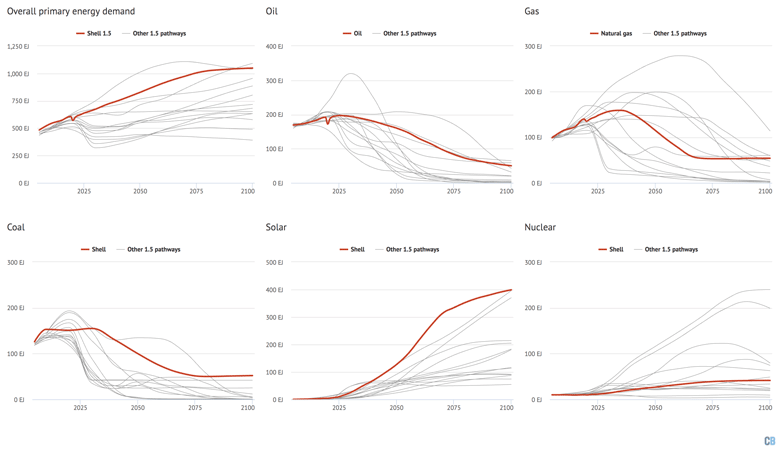
Scenarios with lower energy demand, which tend to be SSP1 and SSP2, focus on energy efficiency rather than demand.
In its report, Shell states that “the energy needs of growing populations seeking a decent quality of life will outstrip the significant capacity to improve energy efficiency”.
Other features of the scenario are relatively high levels of coal and oil being used until the end of the century, although gas use is closer to the average. As with the previous Sky scenario, the new version includes very high levels of solar.
As for CO2 emissions, here Shell’s Sky 1.5 scenario tracks fairly high when compared with other scenarios, as the chart below indicates. This fits with the relatively high carbon budget used by Shell for this scenario.
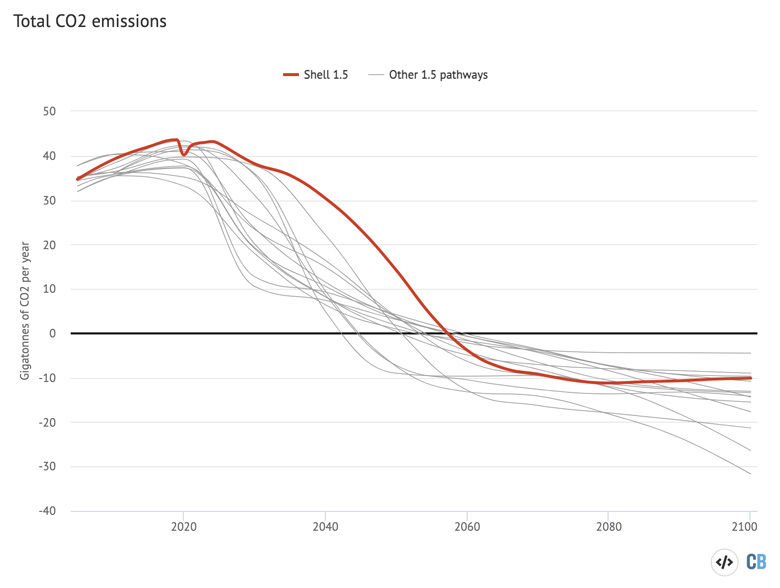
Shell has committed to becoming a “net-zero emissions energy business by 2050”, including the emissions from consumers burning the fossil fuels it extracts and refines.
It has said it intends to offset its emissions through a combination of CCS and nature-based solutions, with plans to remove 25MtCO2 from the atmosphere every year by 2035. All emissions, including the “scope 3” variety from fuels and products sold, will be offset under its plans.
Shell’s Sky 1.5 scenario includes a significant role for CCS, although this is not unusual. Despite CCS technology still being at a relatively early stage of development, it features heavily in most 1.5C and 2C scenarios.
This reliance can be seen in the chart below, which shows that Shell’s pathway is actually towards the lower end of estimates for CCS removals.
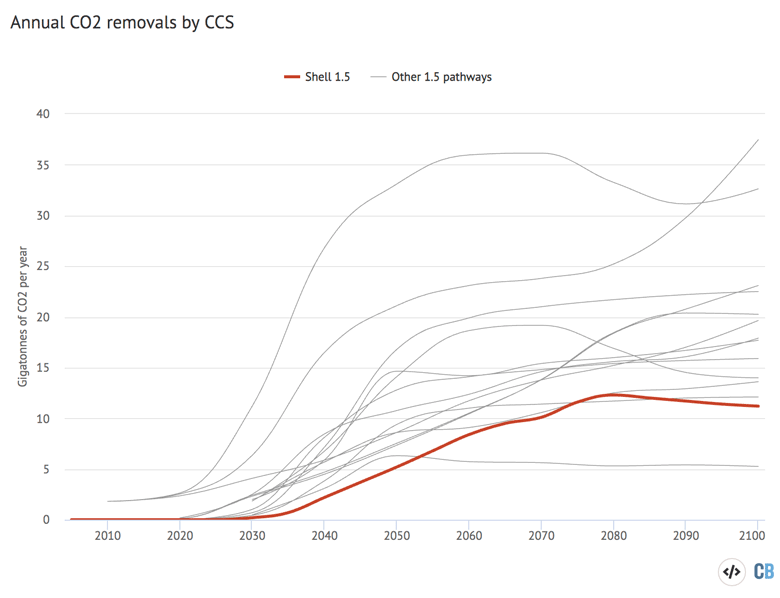
Aside from a reliance on carbon removals, Shell has also received criticism for placing too much emphasis on the role of customers and wider society to make changes while failing to make actual cuts to its oil and gas production.
Responding to the suggestion that Shell’s Sky 1.5 scenario still includes a considerable role for fossil fuels, Bentham tells Carbon Brief “the world will continue to need oil throughout the century”:
“Sectors, such as industries that produce iron, steel, cement, plastic and chemicals and certain types of transport – the foundations of economic development – currently rely on the unique ability of hydrocarbons like oil, natural gas and coal to provide extremely high temperatures, chemical reactions or dense energy storage. Many of these cannot be electrified at all using current technology, or only at a prohibitively high cost.”
-
Analysis: Shell says new ‘Brazil-sized’ forest would be needed to meet 1.5C climate goal
-
In-depth: How does Shell’s new ‘pathway’ limit global warming to 1.5C?

